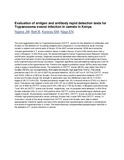| dc.description.abstract | The card agglutination test for Trypanosoma evansi (CATT/T. evansi) for the detection of antibodies, and Suratex for the detection of circulating antigens were compared in a cross-sectional study involving camels in eastern and central parts of Kenya. Of the 2227 camels screened, 2038 were owned by nomadic pastoralists in T. evansi endemic areas in eastern Kenya. A herd of 86 camels were from a ranch in Mugwoni. In Athi River area, 35 camels belonged to Kenya Trypanosomiasis Research Institute, and 68 were slaughter animals. Diagnostic sensitivity estimates were obtained by testing sera from 51 camels that had been found to be parasitologically positive by the haematocrit centrifugation technique, buffy-coat technique and mouse inoculation. Diagnostic specificity was estimated by testing sera from 35 camels known to be trypanosome-free. Positive and negative predictive values (NPVs) were calculated using a range of prevalence values. The sensitivity of CATT/T. evansi (68.6%) was higher than that of Suratex (58.8%), but not significantly. Both tests had equally high specificity (100%). The overall prevalence was 2.3% (51 out of 2227) by parasite detection, 32.2% (327 out of 1017) by CATT/T. evansi and 19.6% (188 out of 961) by Suratex. Overall, there was a positive association between CATT/T. evansi and Suratex though the strength of association was low (McNemar's test=46.12, P=0.001; kappa=0.26, CI: 0.20-0.33). Parasite prevalence ranged from 0% in several herds to 27.8% in a herd in Isiolo. Prevalence was highest in Isiolo with 2.5% (51 out of 2030) by parasitological detection, 38.8% (321 out of 828) by CATT/T. evansi and 21.9% (169 out of 772) by Suratex. In Mugwoni prevalence was 7 and 18% by CATT/T. evansi and Suratex, respectively, and no parasites were detected. In Athi River Suratex detected 2.9% (3 out of 103) positive while CATT/T. evansi and parasitological methods gave negative results. At prevalence values between 10 and 100%, CATT/T. evansi as well as Suratex had infinitely high positive predictive values, whereas Suratex had a lower NPV than CATT/T. evansi. In conclusion, results of this study showed that CATT/T. evansi and Suratex were able to detect aparasitaemic infections rapidly and were more sensitive than parasitological methods in revealing the true extent of trypanosomosis in a herd. The tests effectively complemented parasitological methods in the detection of T. evansi infections in camels. | en_US |

